The city, they call her Valentia;
But I think her name is Lover.
Where else could brick and wood and stone
imbue the air with romantic adoration
so compelling that her legions go
to death with roars of joy?
How could she but be a mistress?
Urbem, Quam Dicunt Valentiam, trans. Rufus Polonius
The proud and ancient name of Valentia encompasses both the Republic and the city which spawned it. The city of Valentia itself is the oldest continually-occupied settlement and the largest city (by area) in all of Eleutheria, and encompasses the entirety of the Province of Capitolina, one of the seven provinces of the Republic. The city was initially located many scores of leagues away, on the shores of a now-lost continent, and was called Aventinus. During the migration caused by the Hiems Perpetua, much of the building material, and the very structures of the great landmarks of the city--were painstakingly disassembled and carried through the migration to the new continent. The second founding of the city saw it renamed anew as Valentia, in memory of the old continent. With this glorious primacy of place in the hearts of Eleutherians, Valentia maintains a rich history and a vibrant culture.
Geography[]
The City hugs the southwestern shore of the continent of Aurelia, nestled between the Citadel island and the mouth of the mighty Trajanis River, with the Sea of Levant providing a border to the south and the Pacis Bay to the west. Due to its southern location and long coastline, Valentia possesses a warm climate and a higher-than-average temperature. Snow rarely falls in Valentia, and the nearest forests are deciduous in nature, although the vast majority of Valentia's lands are rolling grasslands and prairies. Iron and anthracite coal are both abundant below the earth, but the winding mineshafts of ancient civilizations have removed many of the diamonds that formerly studded the deep chasms of Eleutheria.
City Districts[]
The streets of Valentia form a rough grid, with a street and address numbering system designed for ease of use for new arrivals and citizens alike to navigate to the many shops, monuments, and inns throughout the city. The city of Valentia is divided into six Districts, which are general regions of buildings holding a similar purpose: Citadel, Port, Merchant, Patrician, Civic, and Residential.
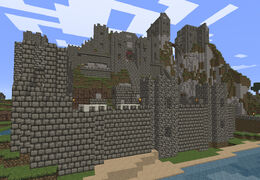
The Citadel, the seat of power in Valentia.
Citadel District[]
The Citadel District is the most ancient district in both the city of Valentia and the continent of Aurelia itself. The lighthouse near the main keep of the Citadel was the first structure built in Aurelia, serving as a beacon to the vast flotilla of refugees arriving from the abandoned cities of Eleutheria. The dominant structure of the district is the Citadel, the vast fortress that dominates not only the island, but the entire city. The open areas of the island bounded by the vast stone walls contains few shops or houses, and most buildings not expressly martial in design and function serve secondary roles to defense: forges, smithys, infirmaries, and storehouses. The Citadel District, therefore, can be best characterized as a heavily-fortified island, designed to be the last defensive position of the city itself.
Port District[]
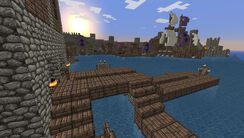
The sun rises over the Port District.
The Port District has over time become the center for shipbuilding in all of Aurelia, buoyed up in the marketplace by high-quality vessels and a well-designed dock area that provides ample room for ships and crews to offload and load cargo from all across Eleutheria. The port district includes shipbuilding facilities, drydocks, quays, several naval supply stores, and a number of inns catering to mariners. A number of insulae also border the river, home to the port workers and the less fortunate members of Valentian society. The boundaries of the Port District run along the Via Auri, Via Portae, and the Via Serpentis after it passes over the Edirnos River, encompassing all land between those streets and the sea.
Merchant District[]
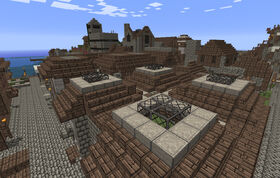
The vast Merchant District.
The merchant district runs along the artery that carries the lifeblood of Valentia between its provinces, the Via Flavii. The marketeers, merchants, and shopkeepers that keep their businesses along this road earn hundreds of denarii every day, creating vast sums of new wealth through their joyous embrace of the market. For many visitors to Valentia, this district is second only to the Civic District in attraction, as the colors, sights, and sounds of a thousand products sold in scores of shops overwhelm the senses. The Merchant district is large, following the Via Flavii from the Via Portae to the Forum Nautarum, clustering largely on the eastern side but also including a strip of land to the western side of the road.
Patrician District
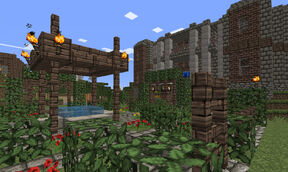
Gardens and villas in the Patrician District.
The Patrician District is a large area home to the oldest and most dignified families of the Republic. Many former and present consuls, proconsuls, and senators have built large villas here, attempting to outdo one another in opulence and grandeur. Each villa is separated from the others by gardens, fountains, and picturesque paths, creating a separate "country within the city." The entire district is separated from the remainder of the city by gates and iron fences, and sits north of the Via Auri, west of the Via Pyropi, and south of the Senate. While some insulae-dwellers look upon the Patrician District with scorn or jealousy, the district is a place of honor for those who have served Valentia with distinction and glory.
Civic District[]
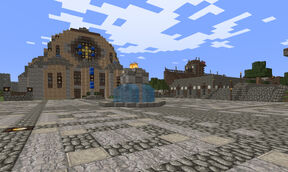
The Basilica as viewed from the Forum.
The Civic District is the heart of the city of Valentia, the home of all the structures of church and state that mark the city as the seat of the Republic of Valentia. The Civic District includes the great Forum Nautarum, the open-air market and meeting place for festivals, debates, and plays--the true social center of Valentia. Two other major civic structures of Valentia also border this forum: the Basilica of St. Martin to the east and the Senate to the west. Further north, the district extends in a strip on either side of the Via Flavii to encompass the foreign embassies of Valentia's allies. Finally, to the east, the Stadium serves as the entertainment center of the city.
Residential District[]
The final district of the city of Valentia is the Residential District, the large area where many of her citizens reside. The district is bifurcated into western and eastern halves by the Via Flavii and the foreign embassies, and lies entirely to the north of the Civic District. Room remains for more inhabitants to build dwellings as the city continues to expand.
Architecture[]
The ideals of Valentian architecture are realized within the enormous structures of the Senate, the Basilica of St. Martin, and the Citadel itself. The influence of Valentia's clean, organized style of construction can be seen in Neo-Ostian architecture.
A Brief Timeline of Valentia[]
November 24, 10 P.A. - Hamlet of Aventinus founded.
Sextilis 24, 13 P.A. - Dominion of Aurelia formed by two allied cities, Aventinus and Ostia. Flavius, Lord Mayor of Aventinus, named High Lord.
Aprilis 26, 14 P.A. - Aurelia grows to a kingdom with a flood of new citizens. Flavius I named king and installed in the yet-unfinished Chamber of Lords.
Aprilis 29, 14 P.A. - Construction begins on the Basilica of St. Martin
Maius 18, 28 P.A. - abdication of Flavius I; Founding of the Flavian Order of St. Martin
Maius 28, 28 P.A. - Coronation of Flavius II
November 26, 31 P.A. - Hiems Perpetua begins. The oceans begin to freeze over, snow covers the farms.
Quintilis 6, 33 P.A. - The Council of Lords holds an emergency session and decides that a migration is necessary for survival.
Quintilis 25, 33 P.A. - The migration across the ice begins.
October 2, 33 P.A. - The end of the ice floes. With the open ocean ahead, ships are built and the journey continues.
Martius 7, 34 P.A. - Arrival at the new continent. The city of Valentia is founded, named in memory of the old continent..
Maius 28, 35 P.A. - The Kingdom of Aurelia is formally dissolved by King Flavius II, and the continent named Aurelia to perpetuate the memory of Eleutheria's first organized multi-city political entity.
